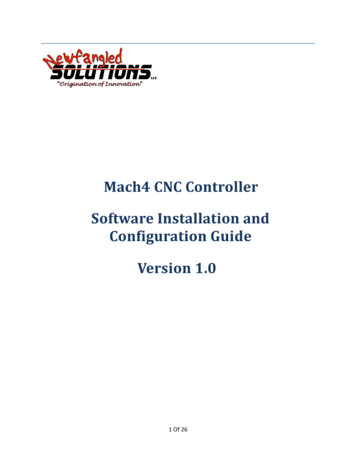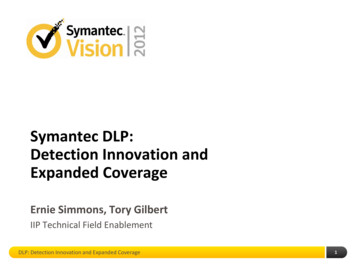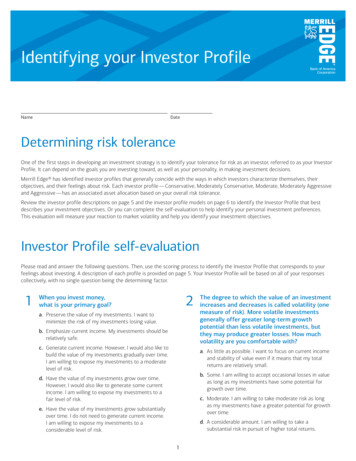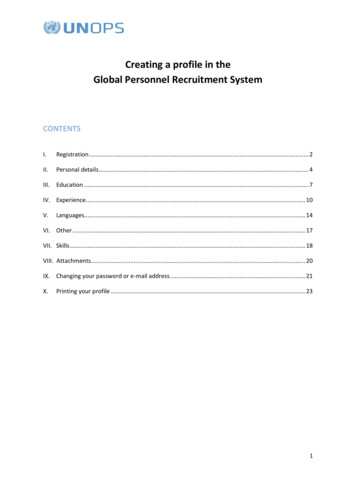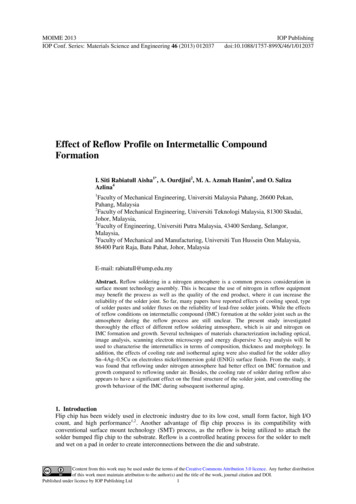
Transcription
MOIME 2013IOP Conf. Series: Materials Science and Engineering 46 (2013) 012037IOP Publishingdoi:10.1088/1757-899X/46/1/012037Effect of Reflow Profile on Intermetallic CompoundFormationI. Siti Rabiatull Aisha1*, A. Ourdjini2, M. A. Azmah Hanim3, and O. SalizaAzlina41Faculty of Mechanical Engineering, Universiti Malaysia Pahang, 26600 Pekan,Pahang, Malaysia2Faculty of Mechanical Engineering, Universiti Teknologi Malaysia, 81300 Skudai,Johor, Malaysia,3Faculty of Engineering, Universiti Putra Malaysia, 43400 Serdang, Selangor,Malaysia,4Faculty of Mechanical and Manufacturing, Universiti Tun Hussein Onn Malaysia,86400 Parit Raja, Batu Pahat, Johor, MalaysiaE-mail: rabiatull@ump.edu.myAbstract. Reflow soldering in a nitrogen atmosphere is a common process consideration insurface mount technology assembly. This is because the use of nitrogen in reflow equipmentmay benefit the process as well as the quality of the end product, where it can increase thereliability of the solder joint. So far, many papers have reported effects of cooling speed, typeof solder pastes and solder fluxes on the reliability of lead-free solder joints. While the effectsof reflow conditions on intermetallic compound (IMC) formation at the solder joint such as theatmosphere during the reflow process are still unclear. The present study investigatedthoroughly the effect of different reflow soldering atmosphere, which is air and nitrogen onIMC formation and growth. Several techniques of materials characterization including optical,image analysis, scanning electron microscopy and energy dispersive X-ray analysis will beused to characterise the intermetallics in terms of composition, thickness and morphology. Inaddition, the effects of cooling rate and isothermal aging were also studied for the solder alloySn–4Ag–0.5Cu on electroless nickel/immersion gold (ENIG) surface finish. From the study, itwas found that reflowing under nitrogen atmosphere had better effect on IMC formation andgrowth compared to reflowing under air. Besides, the cooling rate of solder during reflow alsoappears to have a significant effect on the final structure of the solder joint, and controlling thegrowth behaviour of the IMC during subsequent isothermal aging.1. IntroductionFlip chip has been widely used in electronic industry due to its low cost, small form factor, high I/Ocount, and high performance1,2. Another advantage of flip chip process is its compatibility withconventional surface mount technology (SMT) process, as the reflow is being utilized to attach thesolder bumped flip chip to the substrate. Reflow is a controlled heating process for the solder to meltand wet on a pad in order to create interconnections between the die and substrate.Content from this work may be used under the terms of the Creative Commons Attribution 3.0 licence. Any further distributionof this work must maintain attribution to the author(s) and the title of the work, journal citation and DOI.Published under licence by IOP Publishing Ltd1
MOIME 2013IOP Conf. Series: Materials Science and Engineering 46 (2013) 012037IOP , with downsizing and requirements for faster and cheaper electronic devices, a strongdemand has arisen for high soldering reliabilities. A reliable soldered joint should perform bothmechanical and electrical functions without failure during its service life. Manufacturers need tooptimize many materials and processing factors to control the quality of their products. Solder jointreliability is influenced by various factors such as the type of solder paste, solder paste volume, paddesign, aperture design, board finish, assembly arrangement, and reflow temperatureprofile/atmosphere1,3. However, the current study will only focused on the effect of reflow profile andreflow atmosphere onto intermetallic compound (IMC) formation.Several parameters related to reflow profile may affect the solder joint formation including soak time,ramp rate, peak temperature, time above liquidus and ramp rate during cooling2. Previous researchinvestigating lead-free reflow profile of solder bumps on FR4 substrates reported that the mostsignificant factor in achieving a joint with a thin IMC layer and fine microstructure is the peaktemperature3. In another study on the effect of the reflow peak temperature and time above liquidus(TAL) on both Sn-Pb and Sn-Ag-Cu lead free solder joint shear strength with four different chipresistors on FR4 substrate confirmed that both reflow peak temperature and TAL of reflow profile arethe most critical factors in terms of package shear strength for Sn-Ag-Cu solder joints4. In recentyears, greater attention has been drawn to understanding the formation and growth of the IMC layerand its effect on solder joint reliability in electronic packaging industries with Pb-free applicationneeds5, 6. It is generally accepted that an increase in IMC layer thickness decreases the lifetime ofsolder joints. Typically, the IMC layer thickness strongly depends on reflow process conditions suchas time above liquidus and peak temperature7-9. The correlation between reflow process and IMC layerhas been investigated to determine an ideal reflow process condition that would achieve reliable solderjoints during thermal cycling testing using statistical analysis10.2. Materials and MethodsFirst, the copper substrate was subjected to a pretreatment process to remove oxides and activate thesurface before the desired finish layers are deposited. Then, an ENIG surface finish was deposited onthe substrate having the dimensions (width x length x thickness) of 45 x 50 x 1 mm. Prior to soldering,a dry solder mask was laminated onto the plated substrates using a laminated machine. Then, thesolder mask was exposed to an ultraviolet (UV) light through a patterned film. The exposure was toensure an array of pads is made onto the solder mask upon subsequent development stage in thedeveloping solution. The substrates were then populated with Sn-4Ag-0.5Cu (SAC405) solder spheresof 500µm. The solder spheres were arranged in several rows and bonding to form the solder joints wasmade by reflow in a furnace with the peak reflow temperature set at 250oC. Prior to soldering, allsubstrates were treated with a no clean flux to remove surface oxide. In order to reveal the morphologyof IMC formed during the soldering process a useful method of selective chemical etching of the topsurface was employed and examination of the IMC was made by means of scanning electronmicroscopy. Energy dispersive x-ray (EDX) was used to identify the type and composition of IMCformed.3. Results and Discussion3.1. Effect of Reflow ProfileIt is an established fact that the final structure of solder joint depends on the reflow profile, and inparticular the cooling rate. In order to determine the influence of cooling rate on the solder jointstructure, two different reflow profiles were used as shown in Figure 1 and 2. The reflow profileshown in Figure 1 has slower cooling rate than that in Figure 2. In addition, the atmosphere withinwhich reflow was conducted was also different. Reflow was conducted in air (Figure 1) and under2
MOIME 2013IOP Conf. Series: Materials Science and Engineering 46 (2013) 012037IOP n (Figure 2). In subsequent discussion, the reflow profiles will be labeled as reflow A for theslower post-reflow cooling rate and reflow B for the fast post-reflow cooling rate.Figure 1. Reflow profile A with a slow post-reflow cooling rate.Figure 2. Reflow profile B with a fast post-reflow cooling rateAfter reflow soldering, Sn and Cu (from solder alloy) and Ni and Cu (from the coating and substrate)diffuse towards each other producing IMC. However, the size and shape of this IMC varies dependingon reflow condition. Figure 3 shows the top surface views of samples reflowed by the two differentprofiles. It can be seen that, there was small circle formed at the interface within which the size ofIMC is different from that observed throughout the solder. However, the position of this circle isdifferent between the two reflow profiles was used. This is probably due to the effect of differentatmospheric conditions used, where the interfacial reaction between the solder alloy and substrate wasmuch uniform when nitrogen was used since oxidation can be prevented. Therefore, the solder jointwill be much stronger11.(a)Small circle(b)Small circle3
MOIME 2013IOP Conf. Series: Materials Science and Engineering 46 (2013) 012037IOP Publishingdoi:10.1088/1757-899X/46/1/012037Figure 3. SEM top surface of whole solder after reflow soldering of Sn-4Ag-0.5Cu using differentreflow profiles; (a) reflow profile B on ENIG, and (b) profile A on ENIG.Furthermore, the post-reflow cooling rate also affects the IMC formation. Generally, the fast coolingrate favors nucleation but since the holding time at high temperature zone is shorter, the effective timefor IMC growth is shorter. This results in the formation of a thin layer of fine grained IMCs as shownin Figure 4(a, b). The reason why these fine grains are in needle shape has something to do with thedirect reaction between Sn in the solder and the decomposed Ni from the metastable Ni coating(ENIG). While for the slow cooling rate, nucleation rate is lower but the IMC grains have enough timeto grow. As a result, chunk type IMC becomes dominant and the IMC layer thickness is larger (Figure4(c, d)).(Cu,Ni)6Sn5(a)(b)(Cu,Ni)6Sn5(c)(d)Figure 4. SEM top surface and cross sectional views of Sn-4Ag-0.5Cu after reflow soldering usingdifferent reflow profiles; (a, b) reflow profile B, and (c, d) profile A.It was also found that the IMC growth increased upon aging and post-reflow cooling rate. This is dueto more grain boundaries produced in smaller IMC grain size when reflow profile B was used. Whenmore grain boundaries exist, the diffusion become much easier and faster compared to larger IMCgrain size. As a result IMC grows to a higher thickness for the same aging condition in faster coolingrate samples (Figure 5).Figure 5. Effect of aging duration on IMC thickness using different reflow soldering profiles.Apart from that, needle-type, boomerang-type and chunk-type (Cu, Ni)6Sn5 IMC grains were formedbetween Sn–4Ag–0.5Cu solder and ENIG at different post-reflow cooling rates as can be seen in4
MOIME 2013IOP Conf. Series: Materials Science and Engineering 46 (2013) 012037IOP Publishingdoi:10.1088/1757-899X/46/1/012037Figure 6 and Figure 7. When cooling rate decreases, the amount of needle-type grains also decreases,but the amount of chunk-type and boomerang-type grains increases due to grain growth andcoalescence (Figure 7).The formation of (Cu, Ni)6Sn5 and (Ni, Cu)3Sn4 IMCs are based on the Cu6Sn5 and Ni3Sn4 crystalstructures, respectively. As can be seen in Figure 6 and Figure 7, Cu6Sn5-based IMC was the primaryformed compound during reflow, although the Cu content (0.5 wt.%) in the solder was extremely lowcompared to Sn and Ni. The stable ternary IMC initially formed at the interface after reflow was the(Cu, Ni)6Sn5 due to diffusion of Cu from the solder alloy towards Ni substrate. During aging,interfacial reaction between Ni and Sn-Ag-Cu, Sn, Cu and Ni atoms must diffuse through the existingIMC layer to form interfacial reaction products such as (Cu, Ni)6Sn5. If there was no more Cu presentin the solder material, the Ni3Sn4-based IMC could be stable. However, the solder used in the currentwork was able to provide enough Cu towards the substrate since even after 2000 hours aging, (Cu,Ni)6Sn5 IMC was still dominant. Nevertheless, Figure 7(e, f) shows that there was (Ni, Cu)3Sn4 formedafter 2000 hours aging. This is due to the effect of different reflow atmospheric conditions usedwhereby reflow conducted in oxygen produced non-consistent IMCs’ type throughout the interfacesince corrosion product prevented the Cu atoms to diffuse towards the substrate. Besides, isothermalaging renders the IMC rounder, bigger and more compact for both reflow profiles (Cu,Ni)6Sn5(e)(Cu,Ni)6Sn5(f)(Cu,Ni)6Sn5(g)5
MOIME 2013IOP Conf. Series: Materials Science and Engineering 46 (2013) 012037IOP Publishingdoi:10.1088/1757-899X/46/1/012037Figure 6. SEM top surface of ENIG, as reflow and aged at 150 C, reflowed with Sn-4Ag-0.5Cusolder, mag 4000x using reflow profile B; (a) as reflow mag 2000x, (b) as reflow at small ring, (c) asreflow at near outside, (d) aging 500hours at small ring, (e) aging 500hours at near outside, (f) aging2000hours at small ring, and (g) aging 2000hours at near f)(g(Ni,Cu)3Sn4Figure 7. SEM top surface of ENIG, as reflow and aged at 150 C, reflowed with Sn-4Ag-0.5Cusolder, mag 4000x using reflow profile A; (a) as reflow mag 2000x, (b) as reflow at small ring, (c) asreflow at near outside, (d) aging 500hours at small ring, (e) aging 500hours at near outside, (f) aging2000hours at small ring, and (g) aging 2000hours at near4. ConclusionSeveral conclusions can be made from the study:i. Different reflow profiles produce different morphologies of IMC at the interface during reflowwhich may affect the growth behavior of the IMC after aging.ii. The IMC’s formed during reflow under nitrogen atmosphere were more consistent than thoseproduced when reflow is conducted under air. However, faster cooling rate produced finer IMCgrains which might be translated into a better solder joint strength.6
MOIME 2013IOP Conf. Series: Materials Science and Engineering 46 (2013) 012037IOP Publishingdoi:10.1088/1757-899X/46/1/012037iii. Isothermal aging resulted in increased IMC thickness for both reflow profiles used in air and undernitrogen.AcknowledgmentsThe authors would like to acknowledge the financial support provided by Universiti Malaysia Pahang(vot 120359) for providing the research facilities.References[1] Amalu E. H., Ekere N. N. 2012 Journal of Materials Processing Technology, 212 471[2] Lau C. S., Abdullah M. Z., Ani F. C. 2012 Microelectronics Reliability,[3] Tegehall, P. E. 2011. The ELFNET Book on Failure Mechanisms, Testing Methods, andQuality Issues of Lead-Free Solder Interconnects, pp. 179-195.[4] Pan J. 2006 Soldering & Surface Mount Technology18 48[5] Ladani L. J. 2008 IEEE Transactions on Components and Packaging, 31 51[6] Huang W., Loman J. M., and Sener B. 2002 Microelectronics Reliability, 42, 1229[7] Tu P. L., Chan Y. C., and Lai J. K. L. 1997 IEEE transactions on Components and Packaging, B87[8] Wang, L., Wang, J., Liu, X., and Liu, X. 2010. International Conference on ElectronicPackaging Technology & High Density Packaging (ICEPT-HDP). pp. 181-184.[9] Huang W., Loman J. M., and Sener B. 2002 Microelectronics Reliability 42 1229[10] Arenas M. F., He M., and Acoff V. L. 2006 Journal of Electronic Materials 35 1536[11] Law C. M. T., Wu C. M. L., Yu D. Q., Wang L., and Lai J. K. L. 2006 Journal of ElectronicMaterials 35 897
Effect of Reflow Profile on Intermetallic Compound Formation I. Siti Rabiatull Aisha1*, A. Ourdjini2, M. A. Azmah Hanim3, and O. Saliza Azlina4 1Faculty of Mechanical Engineering, Universiti Malaysia Pahang, 26600 Pekan, Pahang, Malaysia 2Faculty of Mechanical Engineering, Universiti Teknologi Malaysia,



